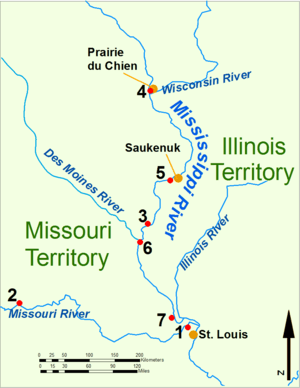Fort Bellefontaine

Fort Bellefontaine was the first United States military installation in the Louisiana Territory.
Located on the south bank of the Missouri River, in present-day Missouri, Fort Bellefontaine was first a Spanish military post.[1] After the Louisiana Purchase, by a treaty made between the United States Government, signed by William H. Harrison and representatives of the Native American Sac and Fox tribes (on November 3, 1804), the fort became a fur trading post of the United States Government. Rudolf Tiller served as factor and Colonel Thomas Hunt served as the military commander.
The trading post was discontinued after 1808, and from 1809 to 1826 the facility served as a United States military fort. During that time period, from about 1809 to 1815, the fort served as the headquarters of the Department of Louisiana, and was the regional Army headquarters during the War of 1812. Its sister forts were Fort Osage along the Missouri near modern Kansas City, which controlled trade with western Indians; and Fort Madison in what is now Iowa, which controlled trade of the Upper Mississippi.
Part of the site of the fort is preserved as the Fort Belle Fontaine County Park, a unit of the park system of St. Louis County, Missouri. An archaeological site associated with the fort was listed on the National Register of Historic Places in 2016.
References
- ↑ Luttig, John C., and edited by Stella Madeleine Drumm, Journal of a Fur-trading Expedition on the Upper Missouri: 1812-1813. Kansas City, MO: The Missouri Historical Society, 1920
External links
- John C. Luttig, Journal of a Fur-trading Expedition on the Upper Missouri: 1812-1813, Kansas City, MO: The Missouri Historical Society, 1920
- Fort Belle Fontaine, US GenNet
Coordinates: 38°49′39″N 90°12′56″W / 38.8274°N 90.2155°W